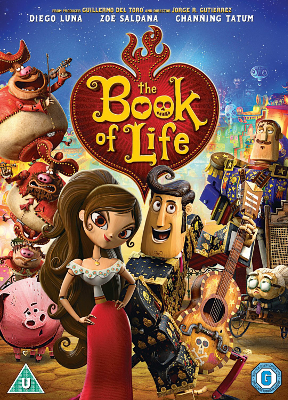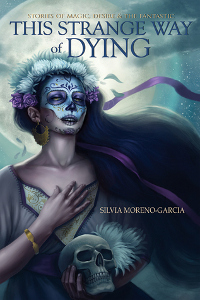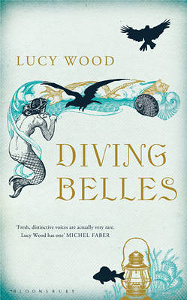 Genre: Children’s Fantasy / Film
Genre: Children’s Fantasy / Film
Main Creative Team: Jorge R. Gutiérrez (director, writer); Doug Langdale (writer); Guillermo del Toro (producer)
Main Cast: Diego Luna; Zoe Saldana; Channing Tatum; Ice Cube; Ron Perlman; Kate del Castillo; Christina Applegate
First Shown: October, 2014
Available: Amazon.com | Amazon UK
A group of school children are taken to see a special exhibit on Mexico, where they hear a story that took place many years ago.
The opening had promise. Once the frame story of the children settles in, the main action in the past gets going. It’s the Day of the Dead, and the rulers of the two lands of the dead are watching. La Muerte (Kate del Castillo) is made of sugar and rules the Land of the Remembered, and Xibalba (Ron Perlman) is made of tar and rules the Land of the Forgotten. They see three children playing and make a wager. This is the point where I got that sinking feeling, and it just kept sinking lower as the story continued. The problem comes down to the wager: which of the two boys will marry the girl when they grow up.
There are things I liked about the film. The visuals were great. The school children are being told the story with wooden models, so the characters in the main story also resemble those models. The Land of the Remembered is particularly beautiful, with vibrant colours and detail. It creates a distinctive animation style.
The two immortals were the highlight for me. Both had great character designs, again with a lot of nice detail. Though they’re introduced as though one is good and one bad, it becomes clear that they’re both rather more ambiguous. I enjoyed the interplay between the two of them.
I also liked the plotline of Manolo (Diego Luna), one of the potential suitors, trying to find his place. He comes from a line of bullfighters, but wants to pursue music. This addresses gender role issues and machoism. Manolo is sensitive and doesn’t want to kill the bulls, which is seen as weak and unmanly.
Joaquín (Channing Tatum), the other suitor, is the son of a famous hero. Joaquín is arrogant and self-centred, but it becomes apparent that it comes from insecurity. He gets to grow into a more caring person as he comes to terms with his own issues.
Then there’s the problem of María (Zoe Saldana). Though María says she’s not a prize to be won, this is wishful thinking on her part. The entire story is about her having to choose one of the men. She gets a choice of which one, but she doesn’t have a choice to do something else with her life or marry someone else. There’s potential for stories to look at how women have very restricted choices at times, but this one failed to go there, because it never acknowledged that she was restricted.
One of the glaring things is that María does not have a personal story outside of the main plot. Manolo is figuring out his place in the world. Joaquín is trying to live up to the legacy of his dead father. But María is just there for the main plot. She was sent away by her father as a child, yet she doesn’t get space to address her family relationships as the others do. She’s highly educated, yet doesn’t have plans on what she might do next. She has combat training, yet when the action scenes roll around, they’re mainly there so the men can reconcile their differences by fighting together. She doesn’t really develop in any way from the María introduced as a child. All the speaking up, knowing how to fight, and being educated, serves to make her a more valuable prize. It doesn’t mean she gets treated as an equal part of the story.
Even for viewers who don’t have the same issue I did, and think love triangles are amazing, there’s no tension to this one. It’s obvious who she’ll marry from the start. There are no surprises here.
The setting could have told any story. The wager could have been anything. It could have gone in a direction no one expected and still have a happy ending. Instead, the main plotline was this, which really didn’t do justice to the characters and setting.
 Genre: Children’s Fantasy / Film
Genre: Children’s Fantasy / Film First Published: 1st September, 2013
First Published: 1st September, 2013
